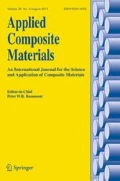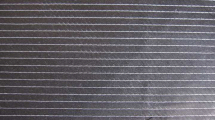Abstract
We propose a new experimental method using a Hassler cell and air injection to measure the permeability of fiber preform while avoiding a race tracking effect. This method was proven to be particularly efficient to measure very low through-thickness permeability of preform fabricated by automated dry fiber placement. To validate the reliability of the permeability measurement, the experiments of viscous liquid infusion into the preform with or without a distribution medium were performed. The experimental data of flow front advancement was compared with the numerical simulation result using the permeability values obtained by the Hassler cell permeability measurement set-up as well as by the liquid infusion experiments. To address the computational cost issue, the model for the equivalent permeability of distribution medium was employed in the numerical simulation of liquid flow. The new concept using air injection and Hassler cell for the fiber preform permeability measurement was shown to be reliable and efficient.









Similar content being viewed by others
References
Marsh, G.: Airbus takes on Boeing with reinforced plastic A350 XWB. Reinf Plast. 51(11), 26–29 (2007)
Belhaj, M., et al.: Dry fiber automated placement of carbon fibrous preforms. Composites Part B. 50, 107–111 (2013)
Arnold, M., et al.: Influence of textile parameters on the out-of-plane permeability of carbon fiber non-crimp fabrics. Adv Compos Lett. 25(5), 121–126 (2016)
Filomena, C.M., Hornung, J., Stollhofen, H.: Assessing accuracy of gas-driven permeability measurements: a comparative study of diverse Hassler-cell and probe permeameter devices. Solid Earth. 5, 1–11 (2014)
Park, C.H., Saouab, A., Bréard, J., Chatel, S.: A fast solution for liquid resin infusion process and simultaneous identification of distribution medium and preform permeabilities, the 16th international conference on composite materials. Jeju Island, Korea. 21–26 (2011)
Kang, M.K., Lee, W.I.: A dual-scale analysis of macroscopic resin flow in vacuum assisted resin transfer molding. Polym Compos. 25(5), 510–520 (2004)
Dong, C.: An equivalent medium method for the vacuum assisted resin transfer molding process simulation. J Compoite Mat. 40, 1193–1213 (2006)
Laine, B.: Influence of the deformations of a fibrous reinforcement on its permeability: modeling and experiments PhD thesis, Ecole Arts et Métiers ParisTech (2008)
Kim, S.K., Opperer, J.G., Kim, D.H., Daniel, I.M.: Determination of in-plane permeability of fiber preforms by the gas flow method using pressure measurements. Polym Compos. 24(1), 34–44 (2003)
Kim, S.K., Opperer, J.G., Daniel, I.M.: Gas flow method for detecting local preform defects by inverse estimation of space-varying permeability. J Compos Mater. 37(15), 1367–1383 (2003)
Opperer, J.G., Kim, S.K., Daniel, I.M.: Characterization of local preform defects in resin transfer molding by the gas flow method and statistical analysis. Compos Sci Technol. 64(13), 1921–1935 (2004)
Levenberg, K.: A method for the solution of certain non-linear problems in least squares. Q Appl Math. 2, 164–168 (1944)
Marquadt, D.: An algorithm for least-squares estimation of nonlinear parameters. SIAM J Appl Math. 11(2), 431–441 (1963)
Govignon, Q., et al.: Full field monitoring of the resin flow and laminate properties during the resin infusion process. Composites Part A. 39(9), 1412–1426 (2008)
Park, C.H., Saouab, A.: Analytical modeling of composite molding by resin infusion with flexible tooling: VARI and RFI processes. J Compos Mater. 43(18), 1877–1900 (2009)
Ouagne, P., et al.: Hydro-mechanical loading and compressibility of fibrous media for resin infusion processes. Int J Mater Form. 3(2), 1287–1294 (2010)
Goncharova, G., Cosson, B., Deléglise-Lagardère, M.: Analytical modeling of composite manufacturing by vacuum assisted infusion with minimal experimental characterization of random fabrics. J Mater Process Technol. 219, 173–180 (2015)
Kang, M.K., Lee, W.I.: A flow-front refinement technique for the numerical simulation of the resin-transfer molding process. Compos Sci Technol. 59(11), 1663–1674 (1999)
Ahn, K.J., Seferis, J.C., Berg, J.C.: Simultaneous measurements of permeability and capillary pressure of thermosetting matrices in woven fabric reinforcements. Polym Compos. 12(3), 146–152 (1991)
Park, C.H., Lee, W.I.: Modeling void formation and unsaturated flow in liquid composite molding processes: a survey and review. J Reinf Plast Compos. 30(11), 957–977 (2011)
Acknowledgements
The first and fourth authors appreciate the financial support from the European Commission to the CANAL (Creating Non-Conventional Laminates) project within the 7th framework program. The second, third and fifth authors would like to acknowledge the European Union (European Regional Development Fund FEDER), the French state and the Hauts-de-France Region Council for co-funding the ELSAT2020 by CISIT project (POPCOM action).
Author information
Authors and Affiliations
Corresponding author
Rights and permissions
About this article
Cite this article
Agogue, R., Chebil, N., Deleglise-Lagardere, M. et al. Efficient Permeability Measurement and Numerical Simulation of the Resin Flow in Low Permeability Preform Fabricated by Automated Dry Fiber Placement. Appl Compos Mater 25, 1169–1182 (2018). https://doi.org/10.1007/s10443-017-9659-8
Received:
Accepted:
Published:
Issue Date:
DOI: https://doi.org/10.1007/s10443-017-9659-8




